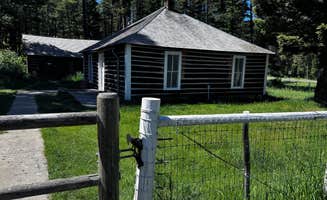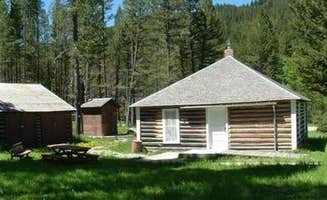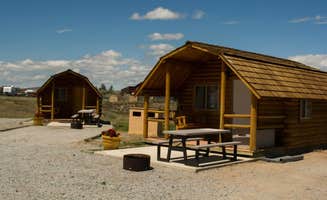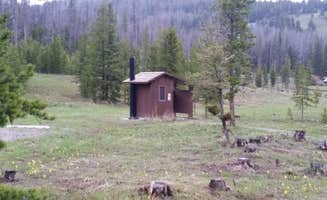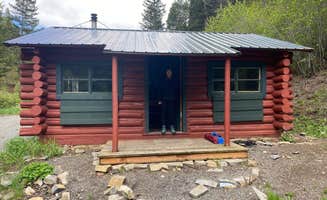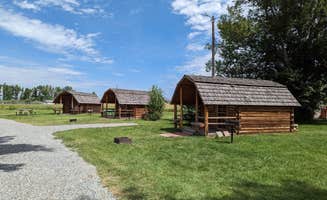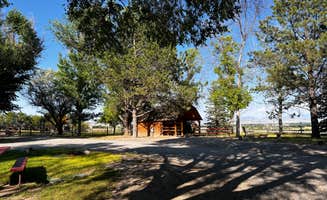Forest service cabin camping near Clancy, Montana offers rustic accommodations in mountainous terrain at elevations between 4,500-6,000 feet. Seasonal accessibility varies significantly, with some locations requiring winter hiking while summer access is generally via maintained forest roads. Temperatures can drop below freezing even in summer months, particularly at higher elevations.
What to do
Hiking trails access: Many cabin locations provide direct access to hiking opportunities. Visitors at Moose Creek Campground can enjoy trails along Moose Creek, which runs alongside the camping area. "Hiking trail right by the cabin, even found some huckleberry nearby," notes a Moose Creek visitor.
Creek exploration: Several cabins feature creeks suitable for summer cooling. "It was quiet and beautiful. The creek is fun to play in! The only negative was all the mosquitos," reports one Moose Creek camper, highlighting the water feature that helps muffle road noise.
Winter adventure opportunities: Snow season transforms the cabin experience. At Strawberry Cabin, visitors can enjoy winter activities. "Everyone had a great time at the cabin. The cabin has a wood stove and firewood was provided," notes a December visitor who reached the cabin after "pulling gear in a sled to the top in light snow."
What campers like
Peaceful seclusion: The remote nature of forest service cabins appeals to many. "This is a nice area especially if you want to be totally isolated because there is no cell phone service here," writes a visitor to Moose Creek Campground. The lack of connectivity is frequently mentioned as a positive feature.
Wildlife viewing: Animal sightings enhance the cabin experience. "Be on the look out for the campground's name sake as Moose to visit the area," advises a Moose Creek visitor. Other locations report deer visits and various wildlife encounters.
Basic comfort amenities: Many cabins offer simple comforts despite their rustic nature. "Gas stove for cooking, wood stove for heat. Shed full of wood, fire pit and vault toilet," reports a visitor about cabin facilities, though they caution to "beware of mice nests."
What you should know
Winter heating considerations: Temperature management becomes important in cold weather. A winter visitor to Strawberry Cabin advises: "Keep the fire small or you will cook in the little cabin, even when its cold outside."
Road and access conditions: Forest roads can present challenges. "The road is a bit rough and the vehicles do not slow down so be careful pulling out onto the main road from the campground area," cautions a Moose Creek visitor. Some cabins require hiking even in good conditions.
Insect preparation: Mosquitos and other pests are common near water. "The bugs can get bad because the creek runs right along side of the road," notes one camper about Moose Creek, suggesting visitors bring repellent.
Supply planning: Canyon Ferry Lake KOA offers some resupply options. "Found the store stocked with some pretty good food that rotates weekly," mentions a visitor, though most forest service cabins require complete self-sufficiency.
Tips for camping with families
Kid-friendly amenities: Several locations offer features specifically for children. Lewis & Clark Caverns State Park provides "a playground if you have kids" and educational opportunities. "Did you know you can print out a packet for your little ones to become Cub Rangers at this State Park?" shares one visitor.
Entertainment options: Indoor activities help during inclement weather. The Strawberry cabin visitor mentioned "plenty of games were in the cabinet to keep everyone entertained," important for family stays.
Group accommodations: Multiple sleeping areas work well for families. According to one camper, "It features a kitchen area, living room and two bedrooms each with two beds," making larger cabins suitable for family groups.
Tips from RVers
Reservation timing: Booking well ahead is essential, especially at popular locations. At Helena North KOA, "Make reservations well in advance if you can. This KOA is the best game in town and is mostly sold out in summer," advises an RV camper.
Site selection considerations: Privacy and spacing vary significantly between sites. "The luxury sites don't have that problem. They are at the end of each row and only have a neighbor on the drivers side. I think well worth the extra 17 bucks," recommends one KOA visitor regarding sewer proximity issues.
Accessibility challenges: Some locations present mobility difficulties. "Not ADA friendly. Very hard for someone with a walker to get around because of gravel roads/sites. Someone with a wheel chair near impossible," notes a Helena North KOA visitor, important information for campers with mobility concerns.



